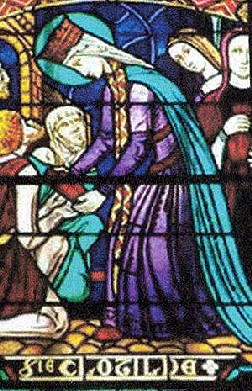That Clotilda was surrounded by such religious personages as Avitus and Patiens lends credence to the theory that she was undoubtedly much influenced by them in the faith. Thus, it is widely accepted that Clotilda’s mother, and perhaps her father, were Catholic. Clotilda’s mother was mentioned by Sidonius who sang her praises (as mentioned previously) and compared her to Tanaquil and Agrippina. As Godefroid Kurth elaborates (Saint Clotilda, 20-21), “each of which recalls the influence exercised by a noble-hearted woman over her husband.” Kurth also explained that while Sidonius was “addicted to hyperbole,” the compliments he gave to the wife of Chilperic II were probably not those of a cloying sycophant. “Sidonius had no affection for the Burgundians, and did not owe allegiance to Chilperic.”
Chilperic II probably died around A.D. 490 and, according to Gregory of Tours, his daughters were supposedly sent to the court of Godegisil in Geneva when Gundobad took the throne at Lyons.* If this is so, it is likely that Chilperic II was the eldest, and when he died, Gundobad assumed the throne as the preeminent king among his remaining brothers.
The death of Chilperic II, as described by Gregory of Tours, has spawned a debate among historians that has filled volumes. According to Gregory, “Gundobad killed his brother Chilperic and drowned Chilperic’s wife after tying a stone round her neck. He drove Chilperic’s two
 daughters into exile: the elder, whose name was Chroma, became a religious, and the younger was called Clotild[a].” (Some believe that the sisters went to Geneva because Godegisil was Catholic, while Gundobad was an Arian). This is the first example of how Gregory is, as Edward James (The Origins of France, 23) puts it, "on the whole hostile to Gundobad."
daughters into exile: the elder, whose name was Chroma, became a religious, and the younger was called Clotild[a].” (Some believe that the sisters went to Geneva because Godegisil was Catholic, while Gundobad was an Arian). This is the first example of how Gregory is, as Edward James (The Origins of France, 23) puts it, "on the whole hostile to Gundobad."In Geneva, we are told that Clotilda became a pious Christian and she and her sister performed charitable deeds. According to Fredegarius, Sedeluba founded the Church of St Victor in the outskirts of Geneva and disappeared from the pages of history. Clotilda was also pious--she was said to have washed the feet of the poor--however, unlike her sister, Clotilda had a still larger role to play in Merovingian history.
=========================
* While it's not impossible to imagine Clotilda shuttling between the courts of her uncles in Geneva and Lyons, as will be discussed in the future, Gregory's story of Clotilda's engagement and betrothal to Clovis implies Clotilda is at Gundobad's court (which is in Lyons), not Geneva.**
** Incidentally, I'm not even sure if "court" is the proper term for whatever you called the place from which the Burgundian (and other barbarian) kings managed their holdings.
UP NEXT: Marriage of Clovis and Clotilda
SOURCES:
Godefroid Kurth, Saint Clotilda, trans. V.M. Crawford with a preface by G. Tyrell (London: Duckworth & Co., 1898).
Avitus of Vienne, Shanzer and Wood.
Gregory of Tours, The History of the Franks.
James, The Origins of France.
Fredegarius, Chronicle of Fredegar.
No comments:
Post a Comment